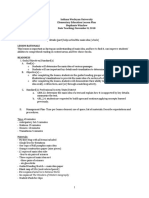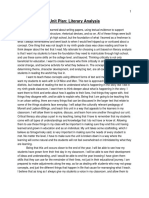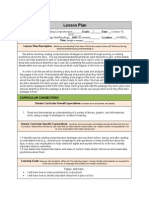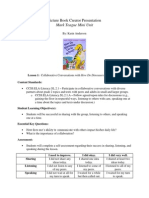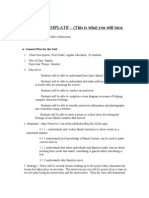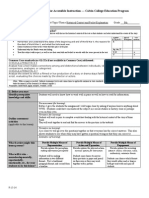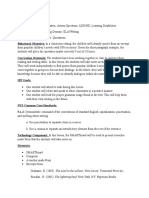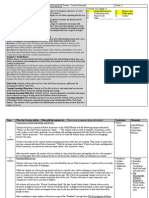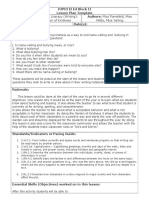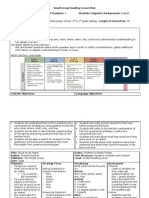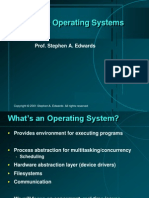Small-Group Inquiry Model For Inquiry Project Stage Teacher Role Student Role Immerse
Small-Group Inquiry Model For Inquiry Project Stage Teacher Role Student Role Immerse
Uploaded by
bronkscottemaCopyright:
Available Formats
Small-Group Inquiry Model For Inquiry Project Stage Teacher Role Student Role Immerse
Small-Group Inquiry Model For Inquiry Project Stage Teacher Role Student Role Immerse
Uploaded by
bronkscottemaOriginal Description:
Original Title
Copyright
Available Formats
Share this document
Did you find this document useful?
Is this content inappropriate?
Copyright:
Available Formats
Small-Group Inquiry Model For Inquiry Project Stage Teacher Role Student Role Immerse
Small-Group Inquiry Model For Inquiry Project Stage Teacher Role Student Role Immerse
Uploaded by
bronkscottemaCopyright:
Available Formats
Stage Immerse Invite curiosity, build background, surround with materials, modeling, thinkingaloud
Small-Group Inquiry Model For Inquiry Project Teacher Role Starting with a map of the world I will say how did humans get here? Making sure to emphasize that no idea will go unheard. Leading questions will be: Where do you think the people came from? What continent or part of the world? How did they travel here by boat, road, or other means of transportation? When did they travel here? Why did they travel here, because they have to have a reason?
http://educationportal.com/academy/lesson/nativeamerican-history-origin-of-tribesand-cultures.html#lesson Watch the video The students will then be given the task. The students will break into 5 groups of 5-6 kids by selecting out of a hat with the labels, NW, SW, M, NE, and SE.
Student Role
The students will have many ideas and thoughts and we will take 5 minutes to journal on how people got to the United States. We will pair share some ideas We will whole class share some ideas The students will watch the video The students will note the three ideas Pair share what idea they like best Class share what idea they like the best They will complete their journal entry with what theory they like the most and why. Think about what the task means. While the students listen they will find their new table in the direction they have chosen. If they have desks they will cluster them together if they work at tables they will move to those respective tables. The students will gather the necessary resources. The rest of the time will be just going through the resources.
In my class all though a large rectangle I will have boxes with the resources in the respective areas of the room by cardinal
direction. Eastern woodland (northeast), Southeast, Great Plains will be in the middle, Southwest and Northwest. Question toss-where the students will write down any questions and toss them on the floor by the whiteboard I will be modeling and teaching two strategies with 2 of the more advanced books. Warpaths by Steele, Crossing Bok Chitto, and Brother Eagle, Sister Sky. These 3 books are important but will not be used in their entirety. I will select sections of the books that will help the groups learn about Native American history and culture. The other book I will be modeling along with them is native homes. This book covers the different shelters of the area and key information about how they lived. I will be asking important questions like why did they use those materials? Do you think this holds up well for their life style? The goal by the end of my read aloud and modeling is for the The students will listen carefully as I use the document camera and read the text aloud to them, writing any information they deem necessary, knowing that they are going to retell what they hear from the book Warpath The students will use Reaction Review Guide with Crossing Bok Chitto, and Brother Eagle, Sister Sky. The students will with these sections start writing down comparisons and contrasting elements with their particular region. Students with the leading questions from the Native Homes book will then be allowed to finally dig into their resources. After seeing how I modeled and asked certain questions, hopefully they will be able to independently start thinking about the resources and their regions. The students will look at their History Alive and America Story books first. Those are clustered by region. They will pair off that book 2 others will work through the If I Lived With series which I will have numerous copies of. The last student
Investigate Develop questions, search for information, discover answers, modeling strategies, guide discussions, conferring
Stage Coalesce Intensify research, synthesize information, modeling organization and evaluating sources, identify key ideas, conferring
Go Public Share learning, demonstrate
children to begin to think about questions of their region. Note card assessment to see what questions there are. Teacher Role The students will return to the resources. The task will be shown once again. They will begin to compile the most valuable research to put in presentation form. They will begin with a long list of research and decide what information is most important to the task. PowerPoint or Keynote will be modeled by me to start the day. A sheet with quick tips and FAQs on the program will be handed out. Facilitate by walking around checking to see if the students are on task. Meet with groups to clarify anything and discuss note card assessment. Reminder of the fact sheet to be used on the giant map. Quick checks of thumbs up and thumbs down Meet with each group before the
will work with a laptop going through the 5 websites researching information. The students will trade off the resources every 5-10 minutes. Student Role I would like them to begin by sharing the information they have found and recorded in the notebooks. The students will continue to work through the textbooks, informational texts, and websites. The students will begin to decide what relevant information to the task is. Taking strategy information and finding a way to include it into group information. Using the Immersion videos and incorporating it into the groups region. Designing the PowerPoint or Keynote slides. Discussing who will say what. Putting information on note cards Compiling any pictures Putting together the fact sheet to be put on the giant map.
Students take notes
learning in a variety of ways, understand, reflect, create new questions
presentations start. What group is going first? Time 5 minutes Talk about eye contact Grading by myself Graded on, quality, pictures, content, and completing the task. Rubrics handed out. Students take notes Final quiz on compare and contrasting the regions.
Listen intently for any differences between their regions. Be respectful and listen to other students presentations. Open Note quiz Put their region fact sheet on the big map that is hanging on the wall.
Rationale for Strategies: Read Remember Represent Retell I will use this strategy with Warpaths by Steele. This book is an upper level book and I will only be reading the first chapter. It does have some pictures of pre colonization and really sets up the period right before first contact. This book will be read by me, the students will take down the important information about the text and try to retell to partners and the whole class about what I have just read. This strategy works really well with this text because of its upper level reading I can make sure the students are gathering what they need from the text. All though just one chapter, I can see if they are taking the information that I deemed necessary. The consistent telling and retelling by the students peers and classmates will make sure the information sets in. This benefits the students greatly because they can hear their classmates put their own spin on the information and it will allow for ELL and other learners to hear it in a voice other than the teachers. It will also help the ELL to tell their own perspectives. This also benefits the class because it allows us to start off on the right foot. With the challenge of this upper level text it will allow me to voice certain vocabulary and difficult phrases into words the students can understand.
Reaction Review Guide For the chapter books Brother Eagle, Sister Sky and Crossing Bok Chitto, the students will be able to hear historical fiction about how lives were for Native Americans. These are chapter books that tell narratives which I am not really concerned about more of the culture the books talk about. The other book is Native Homes, this book talks about the different types of homes Native American people lived in. This book is important for not only their task but to get the creative juices flowing. The students will realize that the homes the Natives built were adaptations to their environment and helped the people survive. The homes were also meaningful to the culture. Teepees are easily deconstructed and moved to the next camp site for the nomadic plains people. These are the types of informational pieces I would like the students to see. This strategy will allow me to model how to look for certain pieces of information in books with a lot of text. I can easily model this with the chapter books that I have preselected parts of different chapters. The Native Homes book will allow me to do it in a more direct way. During this strategy students will be sharing information with partners and their group as a whole. This allows strategy will hopefully be enough for students to work through the texts on their own. With the prior scaffolding of the other strategy with Warpaths, the students will have 2 different strategies to find information in their text and website resources. Differentiation Individual questions with the question toss and an exit card allows me to target questions on group scale but with individual questions. Individual conferencing allows me to meet with students one on one to answer specific questions during the days. The group conferencing before presentations allows me to figure out what problems groups are having. This will allow me to make sure presentations are clean and have no technical issues. Struggling Readers and ELL students are working with groups and hearing a voice other than mine most of the time. Groups will always be divided into subgroups for website and text resource work. The videos will allow the students to visual images of what they are learning about. The strategies will allow students to put the text in their own words. Also all of the books that I have deemed upper level will be modeled by me. The texts are all for grades 3-5. Scaffolding The consistent work of the strategies will help the students go back and look at the work previously done. The assessments like the exit cards and the question toss will allow me to look at possible questions before moving on. The meeting with groups will allow
me to target group and individual questions towards the final project. The journal with the engagement and the strategies on the second day allows the students to visit work from prior days that may answer certain questions. The FAQ sheets for the technology portion of the inquiry will allow students to find answers for themselves.
You might also like
- Handbook of Integrated Circuit Industry: Yangyuan Wang Min-Hwa Chi Jesse Jen-Chung Lou Chun-Zhang ChenDocument2,006 pagesHandbook of Integrated Circuit Industry: Yangyuan Wang Min-Hwa Chi Jesse Jen-Chung Lou Chun-Zhang ChenCICZ 206088No ratings yet
- Guided Reading Lesson PlanDocument8 pagesGuided Reading Lesson Planapi-350000132No ratings yet
- Interactive Read Aloud The Bad SeedDocument5 pagesInteractive Read Aloud The Bad Seedapi-438529073No ratings yet
- Jara B Childs Science Lesson Plan 1Document9 pagesJara B Childs Science Lesson Plan 1api-412552907No ratings yet
- Does Music During Dental Treatment Make A Difference?Document11 pagesDoes Music During Dental Treatment Make A Difference?Vicky Mo100% (1)
- Thunder Cake-RevisionsDocument7 pagesThunder Cake-Revisionshsmith15No ratings yet
- First They Killed My Father An Introduction To The Novel Lesson PlanDocument5 pagesFirst They Killed My Father An Introduction To The Novel Lesson PlanJacjac BattsNo ratings yet
- Unit Plan Assignment 2Document13 pagesUnit Plan Assignment 2api-313149031No ratings yet
- Co Teaching Lesson Plan La MJ Fox Fall 2014Document5 pagesCo Teaching Lesson Plan La MJ Fox Fall 2014api-218636966No ratings yet
- From PA Academic Standards For Science and TechnologyDocument5 pagesFrom PA Academic Standards For Science and TechnologyHyein YunNo ratings yet
- Lesson 2 Something of ValueDocument4 pagesLesson 2 Something of Valueapi-268255123No ratings yet
- CooktechnologylpDocument8 pagesCooktechnologylpapi-300485205No ratings yet
- Immersion Week 2 - Lesson 2Document4 pagesImmersion Week 2 - Lesson 2api-235237171No ratings yet
- Lesson Plan Template Teacher: Content Area/Topic: Grade Level: Lesson Title: LessonDocument6 pagesLesson Plan Template Teacher: Content Area/Topic: Grade Level: Lesson Title: Lessonapi-284296505No ratings yet
- Whole Group Shared Reading Lesson Plan TemplateDocument4 pagesWhole Group Shared Reading Lesson Plan Templateapi-300874571No ratings yet
- Lesson Plan: Curriculum ConnectionsDocument8 pagesLesson Plan: Curriculum Connectionsapi-295933754No ratings yet
- Nancy Levit EditsDocument5 pagesNancy Levit Editsty70001No ratings yet
- Rla525 Anderson Assignment2unitDocument10 pagesRla525 Anderson Assignment2unitapi-259460388No ratings yet
- Immigrant Kids Concept Lesson PlanDocument9 pagesImmigrant Kids Concept Lesson Planapi-280097837No ratings yet
- Strategy Lesson 1Document5 pagesStrategy Lesson 1api-484708169No ratings yet
- Unit PLAN TEMPLATE - (This Is What You Will Turn In) : Tamar KahnDocument15 pagesUnit PLAN TEMPLATE - (This Is What You Will Turn In) : Tamar Kahnbales18No ratings yet
- Unit PLAN TEMPLATE - (This Is What You Will Turn In) : Tamar KahnDocument11 pagesUnit PLAN TEMPLATE - (This Is What You Will Turn In) : Tamar Kahnbales18No ratings yet
- Social Studies Lesson PlanDocument7 pagesSocial Studies Lesson Planapi-404999113No ratings yet
- Indian Studies Lesson PlanDocument5 pagesIndian Studies Lesson Planapi-529723936No ratings yet
- Adapt A LessonDocument5 pagesAdapt A LessonamypeabodyNo ratings yet
- Nerdy BirdyDocument4 pagesNerdy Birdyapi-314784763100% (1)
- Ed 243 Lesson 2 My Monster Mama Loves Me SoDocument3 pagesEd 243 Lesson 2 My Monster Mama Loves Me Soapi-245588668No ratings yet
- Kindergarten Bear Hunt Lesson Plan 3Document3 pagesKindergarten Bear Hunt Lesson Plan 3api-509037992100% (1)
- Analyzing South American Indigenous GroupsDocument12 pagesAnalyzing South American Indigenous Groupsapi-298306126No ratings yet
- Lesson Number 1Document3 pagesLesson Number 1api-284181679No ratings yet
- Lesson PlanDocument4 pagesLesson Planapi-249150996No ratings yet
- Quotations Lesson PlanDocument5 pagesQuotations Lesson Planapi-313105261No ratings yet
- Marzano Lesson PlanDocument7 pagesMarzano Lesson Planapi-271902152No ratings yet
- First Grade Lesson Plan - CTMDocument3 pagesFirst Grade Lesson Plan - CTMapi-540876789No ratings yet
- Ss Unit Lesson 5Document3 pagesSs Unit Lesson 5api-240149563No ratings yet
- Giansante - Ede727 Ela Lesson1 FinalDocument10 pagesGiansante - Ede727 Ela Lesson1 Finalapi-266338559No ratings yet
- InteractivereadaloudDocument7 pagesInteractivereadaloudapi-666859268No ratings yet
- Read Aloud Lesson PlanDocument5 pagesRead Aloud Lesson Planapi-298336851No ratings yet
- Comprehension Reading LessonDocument3 pagesComprehension Reading Lessonapi-248716727No ratings yet
- Lesson Observation 1 EditDocument5 pagesLesson Observation 1 Editapi-385481283No ratings yet
- EDT 415 Wiki Literature Lesson Plan 1Document5 pagesEDT 415 Wiki Literature Lesson Plan 1Anonymous QGjaweUBWNo ratings yet
- 477 Lesson Plan Summer 2013Document12 pages477 Lesson Plan Summer 2013tddhondtNo ratings yet
- Brookes Process Chart1Document8 pagesBrookes Process Chart1api-302109315No ratings yet
- Task 1 LearningsegmentDocument11 pagesTask 1 Learningsegmentapi-353818531No ratings yet
- Classroom Management Plan Rubric/Point ValuesDocument11 pagesClassroom Management Plan Rubric/Point ValuesjackieNo ratings yet
- Garden of KindnessDocument3 pagesGarden of Kindnessapi-354735689No ratings yet
- SocraticseminarDocument6 pagesSocraticseminarapi-271086058No ratings yet
- Curriculm MapDocument11 pagesCurriculm Mapapi-316343255No ratings yet
- Grade 4 Inquiry UnitDocument11 pagesGrade 4 Inquiry Unitapi-318719717No ratings yet
- 2 11 Aunt SusanDocument4 pages2 11 Aunt Susanapi-308910909No ratings yet
- Lesson Plan-MethodsDocument6 pagesLesson Plan-Methodsapi-272643370No ratings yet
- Gathering Information To Construct A How To BookDocument4 pagesGathering Information To Construct A How To BookKatieJewettNo ratings yet
- 1st Lesson Plan... The Community Garden..Document6 pages1st Lesson Plan... The Community Garden..OvalCatNo ratings yet
- Who Am I Lesson PlanDocument8 pagesWho Am I Lesson PlanMaryAnnAnabeNo ratings yet
- Direct Instruction Lesson Plan-Social StudiesDocument2 pagesDirect Instruction Lesson Plan-Social Studiesapi-242763077No ratings yet
- Gather Evidence From The Text. Ask Questions To Help ThemDocument7 pagesGather Evidence From The Text. Ask Questions To Help Themapi-253725168No ratings yet
- EDEL453 Spring2013 MichaelFEHER History Day3Document3 pagesEDEL453 Spring2013 MichaelFEHER History Day3mf150032No ratings yet
- Literacy Lesson Plan First DraftDocument5 pagesLiteracy Lesson Plan First DraftMelina VarneyNo ratings yet
- Smallgroup Lesson PlanDocument7 pagesSmallgroup Lesson PlanJuanita Castro BarreraNo ratings yet
- Takaki Journey Box Lesson PlanDocument6 pagesTakaki Journey Box Lesson Planapi-267854883No ratings yet
- Informational Text Toolkit: Research-based Strategies for the Common Core StandardsFrom EverandInformational Text Toolkit: Research-based Strategies for the Common Core StandardsNo ratings yet
- Strategi Pengembangan Usaha Abon SapiDocument7 pagesStrategi Pengembangan Usaha Abon SapiNisa qur'aniNo ratings yet
- International Research Journal of Pharmacy: A Review On Concept of Cleaning Validation in Pharmaceutical IndustryDocument3 pagesInternational Research Journal of Pharmacy: A Review On Concept of Cleaning Validation in Pharmaceutical IndustryMohamed KamalNo ratings yet
- E-Book On Seven Steps On Effective Workforce PlanningDocument75 pagesE-Book On Seven Steps On Effective Workforce Planningswapnilsalunkhe2000No ratings yet
- Endbreakage RateDocument17 pagesEndbreakage RateNarayanan BalasubramanianNo ratings yet
- JCPT 12081Document7 pagesJCPT 12081belqis ratuNo ratings yet
- Credit Processing Officer (BSC - q2304)Document21 pagesCredit Processing Officer (BSC - q2304)bikram.todowalNo ratings yet
- Between Facets and Domains: 10 Aspects of The Big Five: Colin G. Deyoung Lena C. QuiltyDocument17 pagesBetween Facets and Domains: 10 Aspects of The Big Five: Colin G. Deyoung Lena C. QuiltyAcrismaritei BogdanNo ratings yet
- Kajaria MKTDocument107 pagesKajaria MKTAbhi Sood50% (2)
- Design, Fabrication, and Testing of A Fluidized-Bed Paddy Dryer That Uses A Rice Hull-Fueled Furnace For Prototyping (Journal Article)Document14 pagesDesign, Fabrication, and Testing of A Fluidized-Bed Paddy Dryer That Uses A Rice Hull-Fueled Furnace For Prototyping (Journal Article)Caleb del MundoNo ratings yet
- Chapter 17 Short Informal ReportsDocument8 pagesChapter 17 Short Informal Reportsapi-593787552No ratings yet
- The Influence of Social Networking Sites To The Behavior of G11-Ict of Recto Memorial National High School, S.Y. 2017-2018Document37 pagesThe Influence of Social Networking Sites To The Behavior of G11-Ict of Recto Memorial National High School, S.Y. 2017-2018Krizza BathanNo ratings yet
- IFE MatrixDocument2 pagesIFE MatrixGraciella Tiffany100% (3)
- Chap 3 - Importance of Service ExcellenceDocument7 pagesChap 3 - Importance of Service ExcellenceJulius Hans Gallego100% (2)
- 2120 - ColorDocument11 pages2120 - ColorQodri Maulana Sipahutar100% (1)
- Makhosazana Ndiweni July 2020Document113 pagesMakhosazana Ndiweni July 2020phat elNo ratings yet
- Laptop Use and Its Antecedents Among Educators: A Review of The LiteratureDocument11 pagesLaptop Use and Its Antecedents Among Educators: A Review of The LiteratureSomnath MangarajNo ratings yet
- Four Stage Phil Iri Administration 1Document37 pagesFour Stage Phil Iri Administration 1LOLITA DE LEONNo ratings yet
- Performance ManagementDocument4 pagesPerformance ManagementSalim ShirzadNo ratings yet
- Inverse Problems:: What Are They, How Can We Approach Them, and What Can We Learn From Them?Document38 pagesInverse Problems:: What Are They, How Can We Approach Them, and What Can We Learn From Them?marouen2110No ratings yet
- Detection of Gas Chimney and Its Linkage With Deep-Seated Reservoir inDocument18 pagesDetection of Gas Chimney and Its Linkage With Deep-Seated Reservoir injolugoto1991No ratings yet
- Thesis Temp BBSUL 2024Document25 pagesThesis Temp BBSUL 2024Sumair S.No ratings yet
- S Sathish (Pce) 622014631015Document93 pagesS Sathish (Pce) 622014631015Niranjana DNo ratings yet
- RtosDocument37 pagesRtosMalu MohanNo ratings yet
- Teks Diskusi PLPGDocument6 pagesTeks Diskusi PLPGKarlonius Bambang PurwantoNo ratings yet
- Paresh Vaghani 2003Document72 pagesParesh Vaghani 2003Satish ParmarNo ratings yet
- Magic Bricks ReportDocument27 pagesMagic Bricks ReportAkhil DhamijaNo ratings yet
- Instrument - Family Parenting Scale ECF - 29Document63 pagesInstrument - Family Parenting Scale ECF - 29ScribdTranslationsNo ratings yet


